
 |
|
|
|
||
BOOKSWelcome to the Global Change Associates bookstore. To purchase a book, please click on a title or a book cover below.  Cut Carbon, Grow Profits Cut Carbon, Grow Profitspublished 2007 by Middlesex University Press Cut Carbon, Grow Profits illustrates what every corporation needs to know in order to manage the carbon and sustainability challenges facing societies, cities, individuals and businesses today. With contributions from international experts, Cut Carbon, Grow Profits shows the benefits of incorporating strategic aspects of carbon thinking into the business strategies of companies, their customers and suppliers. In so doing, businesses create sustainable shareholder value, cut costs, increase revenues, build powerful corporate reputations, develop new low-carbon products and services, engage employees, and create powerful brands. Read sample chapter, written by Peter Fusaro (requires Adobe Acrobat Reader to view) 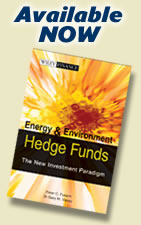 Energy & Environmental Hedge Funds: The New Investment Paradigm Energy & Environmental Hedge Funds: The New Investment Paradigmpublished 2006 by Wiley As the world's energy markets continue to grow, there is a growing need for professional literature on the subject. Sustained higher energy prices are now driving investment interest at an unprecedented level into the energy sector and that is spilling over into the clean technology and environmental financial markets. Energy and Environmental Hedge Funds: The New Investment Paradigm is the first book to cover the universe of energy hedge funds by strategy and to discuss the significant opportunities that they are responding to, not just in energy and energy-related commodities, but across the energy industry in general including equities, debt, assets, alternative energy, carbon and emissions trading, 'green' plays, and arbitrage. Read review from Bloomberg.com 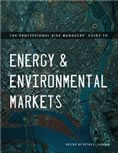 The Professional Risk Managers' Guide to Energy and Environmental Markets The Professional Risk Managers' Guide to Energy and Environmental Markets
published 2006 by PRMIA The Professional Risk Managers' Guide to Energy and Environmental Markets brings these important and developing markets to life for all financial risk managers. Over 450 pages from introductory materials to more advanced risk management themes are covered in this must-read text for anyone affected by energy prices or environmental risks....in short, for all financial risk professionals. 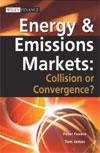 Energy and Emissions Markets: Collision or Convergence? Energy and Emissions Markets: Collision or Convergence?published 2006 by Wiley Written by best selling author Peter C. Fusaro and renowned energy market expert and commentator Tom James, this book demonstrates that the forces of energy and environmental issues and linked more than ever before. The beginning of European emissions and trading in 2005 and the implementation of the Kyoto protocol have accelerated efforts already underway in the US to use market forces to remediate environmental issues. Topics such as emissions trading, renewable energy trading, the fourth dimension in energy trading, and new outcomes on green project finance will be analyzed in this book. Read review from riskbook.com 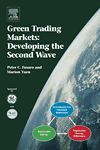 Green Trading Markets: The Second Wave Green Trading Markets: The Second Wavepublished 2005 by Elsevier This is the second in our series of books on Green Trading market evolution and is published by UK publisher Elsevier. Click here to read a sample chapter (requires Adobe Acrobat Reader to view). 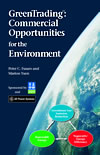 GreenTradingTM: Commercial Opportunities for
the Environment
GreenTradingTM: Commercial Opportunities for
the Environmentpublished 2004 by GreenTrading Inc. Click here to read a sample chapter, the Introduction (requires Adobe Acrobat Reader to view).  Energy Hedging in Asia: Market Structure and Trading Opportunities
Energy Hedging in Asia: Market Structure and Trading Opportunitiespublished 2005 by Palgrave Macmillan This book focuses on the latest developments in the Asia-Pacific community in terms of how deregulation and privatization are bringing more risk to energy companies. What Went Wrong at Enron: Everyone's Guide to the Largest Bankruptcy in U.S. History Paperback, 256 pages published 2002 by John Wiley #8 Best Seller on New York Times paperback list. What Went Wrong at Enron is the first comprehensive and clear explanation of what happened at Enron. Peter C. Fusaro and Ross M. Miller take you inside Enron and show you the who, why, what, where, and when of the sinking of this corporate Titanic. In an engaging style, they explain what happened and uncover the mistakes that led to Enron's fall-in a way that anyone can understand. What Went Wrong at Enron offers a fascinating backdrop to all the whistle-blowing, backstabbing, grandstanding, deception, posturing, and silence that has become the Enron story. "The Enron story, for most of us, is a monster. Fusaro and Miller
clarify what went wrong in a manner that allows anyone to get their arms
around the beast quickly, without killing oneself." "The authors' sharp insights into Enron's self-destructive culture
provide a clear road map into its massive failure."  Energy Convergence: The Beginning of the Multi-Commodity Market
Energy Convergence: The Beginning of the Multi-Commodity MarketHardcover, 254 pages published 2002 by John Wiley An energy investor of the 1970's or 1980's would hardly recognize the energy market of today. Global changes in regulatory structures, privatization efforts, and competitive market forces are engineering a variety of trading innovations. Multinational corporations are consolidating and and constructing new commodities and new markets for trading that are changing the shape of the energy industry. Veteran energy insider Peter Fusaro shows you how to negotiate this shifting terrain and participate in Energy Convergence: The Beginning of the Multi-Commodity Market. Assembing an all-star cast of contributors, Fusaro examines the new developments and their ramifications from every conceivable angle, providing the first comprehensive coverage of all the new markets. Topics addressed include: Weather Derivitives and reinsurance; the developement of bandwith market liquidity; new techniques in energy options; freight trading as an emerging commodity market; market risk in electic generation finance; energy risk management in the merger context; emerging financial markets for protecting the environment. Energy Convergence identifies and addresses the key elements in the ongoing development and evolution of the energy trading markets. This book is an important addition to the literature on contemporary energy trading markets. It pulls together in one place thoughtful discussions about the way energy markets are converging from different starting points." ...A. S. Kramer, partner, McDermott, Will & Emery, author of Financial Products: Taxation, Regulation, and Design. 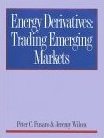 Energy Derivatives: Trading Emerging Markets
Energy Derivatives: Trading Emerging MarketsHardcover, 274 pages published 2000 by Energy Publishing Glogal energy markets are undergoing profound and fundamental structural changes driven by deregulation, privatization, and consolidation. The key factor in all markets is that the level of risk is increasing. To meet the challenges of energy companies, financial engineering is growing exponentially to develop the new financial products for these emerging energy markets. This book captures the new financial products and examines and explains them for the layman. Topics covered include: Telecommunications bandwith trading; Emissions trading, Weather derivatives; Electronic energy trading and Electricity and natural gas trading in Europe. 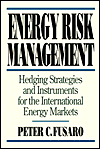 Energy Risk Management: Hedging Strategies and Instruments for the InternationalEnergy Markets Energy Risk Management: Hedging Strategies and Instruments for the InternationalEnergy Markets) Hardcover, 256 pages published 1998 by McGraw-Hill Professional Publishing Energy deregulation, privatization and competition are a hot international topic. Professionals in this field understand the importance of hedging their financial risk, but are often unclear how to do so. The result is that either they take undue and unwarranted risk or they shy away from futures and derivatives investments that could improve their financial position while preventing substantial losses. Energy Risk Management is the first book to address the important issues of worldwide energy price risk management. Peter C. Fusaro has assembled the leading industry figures to explain general theories and practices for hedging risk, and specific methods to effectively manage risk in markets such as coal, natural gas, electricity, hydropower and others. 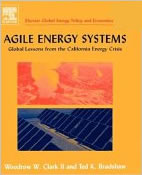 Agile Energy Systems: Global lessons from the California Energy Crisis Agile Energy Systems: Global lessons from the California Energy CrisisElsevier Press, 2004 Due to the recent catastrophic energy system failures in California along with those in the North-Eastern US and Southern Canada, London, and Italy, the time has come to proclaim the failure of deregulation, privatization or liberalization and propose a new energy system. This book shows in the first section, how five precipitating forces led to the deregulation debacle in California: (1) major technological changes and commercialization, (2) regulatory needs mismatched to societal adjustments, (3) inadequate and flawed economic models, (4) lack of vision, goals, and planning leading to energy failures, and (5) failure and lack of economic regional development. download PDF review and order form read review BOOK REVIEW
Agile Energy Systems: Global lessons from the California Energy Crisis
Book Review An Environmental Future must be Agile - so also Energy Systems!! How should the environmentally sound future energy systems be designed when the oil and gas become too expensive? How could blackouts be avoided in the future? Such questions are not a simple matter of introducing new technologies or changing energy polices to privatization or deregulation. The answers are complex and involve a broader and more interdisciplinary approach. Such an approach can be found in a new book called, �Agile Energy Systems� by Woodrow W. Clark II and Ted K. Bradshaw. This book, carrying the subtitle �Global Lessons from the California Energy Crisis,� is literature for a broad range of readers from public and private energy companies to policy makers to energy engineers who are interested particularly in the integration of energy policy with sustainable development relating to environment, social and economic issues. Future environmentally sound energy systems are a matter of both technological development as well as the proper policy design of markets and public regulation; what the authors call in their conclusion as the �civic core� in any region, nation or state. In short, as proposed several years ago, there is a significant need for public-private partnerships or �civic markets,� whereby people with special concerns and interests converge to develop and implement policies and plans that benefit the community, environment, and economy for the short and long-term. This book uses this perspective and to analyze the California energy crisis from June 2000 through the spring of 2001, and continuing past 2005. This ongoing crisis in California (and now worldwide), in which the lights went out in rolling blackouts, deregulation continues to be a mess. Also, the inability of political leaders to develop and implement a new, collaborative, energy plan, has impacted the economic and social growth of California and was responsible, in part, for the �recall� of a Governor, and has caused California to be even more dependent upon �foreign� energy suppliers. The authors present a strategy to avoid such crises in the future and at the same time convert to energy system designs, which are capable of adjusting to future conditions, not only by being based on renewable resources but also by being �agile� and �flexible� to meet the short and long term energy needs of local communities. By introducing the term �agile� the authors refer to an energy system that is flexible but more importantly, a system within any energy, environmental, waste or water infrastructure able to change quickly. An agile system is adept at change, where innovation is welcomed rather than opposed. Agile energy systems are resourceful and are adept at developing ways to avoid or to solve conflicts, while deconstructing social-economic barriers that slow down effective solutions to problems. Agile systems are dynamic and progressive. Agile systems are not limited either from political pressures or constraints from lobbyists and special interests. Instead, such agile systems foster and promote diversity along with dynamic growth from which there is change using knowledge, intellectual capital, financing mechanisms and advanced technologies. In one chapter, the book has a very coherent and informative analysis of relevant new energy technologies such as wind power, geothermal, solar thermal, photovoltaic, CHP (combined heat and power), fuel cells and hydrogen options together with conservation and load management. All the technologies are discussed in the light of being components in agile energy systems. There is not one standard or uniform set of circumstances or technologies that fit all communities and regions. Geothermal is not found everywhere. Nor are sunshine and wind, but the combination of these renewable resources along with new technologies for storage such as fuel cells and flywheels provide for hybrid technologies that create firm base loads and dependable power. Such systems can replace or compliment conventional fossil fuel system or be ready in the transition to fully energy independent on-site and distributed energy systems. Agile Energy Systems are a combination of local or regional energy systems (including on-site, distributed and self-generation) central grid systems that will be used in the future, primarily for redundancy and back-up purposes. These agile systems are not particular technologies or market mechanisms, but rather a paradigm shift that the authors explore to describe this new civic-market-orientation. Such Agile Energy Systems have the following features:
Both government and industry need clear, concise, long-term-oriented and consistent market rules, standards, codes and operating protocols in order to achieve the goals of sustainable society and business. Hence, the civic markets must adhere to five principles, which are outlined for any such framework:
Although the book has highlighted the theory, there are numerous examples which indicate that many steps have already been taken. The authors are academics and researchers in renewable energy issues with international perspectives. Clark is well positioned for discussing and analyzing the California Energy Crisis, since he was recruited to serve as Governor Davis' Energy Advisor for Reliability and focused on the solutions to the crisis in terms of renewable energy, emerging and advanced technologies as well as finance. Bradshaw, a Professor at the University of California, Davis campus in Community Studies is a scholar in community sustainable development and an expert in the energy field for over twenty-five years. I strongly recommend the book to any scientist, engineer or technologist, who wants to understand the complex relations of energy market designs and public regulations. Moreover, this book is a must read for any economist or market analyst who wants to obtain a coherent understanding of the costs, technological and future options for any infrastructure system. Also, of course, the book is indeed relevant and informative to those of us who recognize the need for interdisciplinary approach and want to learn more about how it works in energy and other fields. (*) Henrik Lund is M.Sc. in engineering (1985) and has been associated professor at the Department of Development and Planning at Aalborg University in energy planning since 1993 and head of department from 1996 to 2002. Dr. Lund holds a PhD in �Implementation of Sustainable Energy Systems� (1990). His area of expertise has been energy system analysis, energy planning and energy economics for 20 years. The International Energy Foundation (IEF) gave him a gold medal for �Best Research Paper Award� within the area �Energy Policies &Economics;� in 1998. He has been involved in a number of research projects and committee works in Danish energy planning, and in the implementation of various local energy projects in Denmark as well as in other countries. In 2001 he was member of an expert group analysing �management of fluctuations in electricity production from renewable energy and CHP� conducted by the Danish Energy Agency for the Danish Parliament. 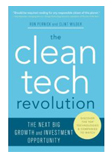 The Clean Tech Revolution The Clean Tech Revolutionpublished 2007 In The Clean Tech Revolution, authors Ron Pernick and Clint Wilder identify the major forces that have pushed clean tech from back-to-the-earth utopian dream to its current revolution among the inner circles of corporate boardrooms, on Wall Street trading floors, and in government offices around the globe. By highlighting eight major clean-tech sectors - solar energy, wind power, biofuels and biomaterials, green buildings, personal transportation, the smart grid, mobile applications, and water filtration - they uncover how investors, entrepreneurs, and individuals can profit from this next wave of technological innovation. Finally, Pernick and Wilder shine the spotlight on the winners among technologies, companies, and regions that are likely to reap the greatest benefits from clean tech-and they show you why the time to act is now. 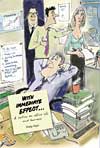 With Immediate Effect With Immediate Effectpublished 2004 What happens when an honest but bored, frustrated, inexperienced and unexpectedly- promoted office worker tries to cope with novel business and social challenges in today's odd world? This is the humorous account of a UK businessman working around the bureaucratic limitation of systems to reduce greenhouse gases and reduce climate change. 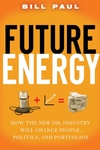 Future Energy: How the New Oil Industry Will Change People, Politics and Portfolios Future Energy: How the New Oil Industry Will Change People, Politics and Portfoliospublished 2004 With oil prices having doubled since 2003, the world is in the grip of an energy crunch that promises to get even worse. A "perfect storm" of rapidly rising demand, political insecurity, environmental restrictions, signs of diminishing resources, and increasingly violent weather patterns are driving prices steadily higher. What does all this mean for the U.S. and global economies? How can the average investor navigate this storm? Answering these and other questions, Future Energy is a step-by-step guide on where to invest now and over the next several years. This timely book takes investors far beyond the usual suspects on a fascinating exploration of how high energy prices create opportunities for the average investor to make money from a wide variety of technologies, industries, and individual companies. |